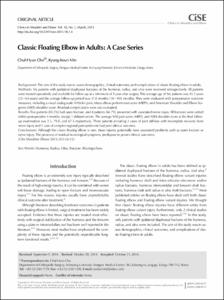KUMEL Repository
1. Journal Papers (연구논문)
1. School of Medicine (의과대학)
Dept. of Orthopedic Surgery (정형외과학)
Classic Floating Elbow in Adults - A Case Series
- Keimyung Author(s)
- Cho, Chul Hyun
- Department
- Dept. of Orthopedic Surgery (정형외과학)
- Journal Title
- 대한견주관절학회지
- Issued Date
- 2015
- Volume
- 18
- Issue
- 1
- Abstract
- Background: The aim of this study was to assess demographics, clinical outcomes, and complications of classic floating elbow in adults. Methods: Six patients with ipsilateral diaphyseal fractures of the humerus, radius, and ulna were reviewed retrospectively. All patients were treated operatively and available for follow-up at a minimum of 1 year after surgery. The average age of the patients was 45.2 years (22-64 years) and the average follow-up period was 37.0 months (14-103 months). They were evaluated with postoperative outcome measures, including a visual analog scale (VAS) for pain, Mayo elbow performance score (MEPS), and American Shoulder and Elbow Surgeons (ASES) shoulder score. Residual complications were also evaluated. Results: Five patients (83.3%) had open fracture, and 4 patients (66.7%) presented with associated nerve injury. All fractures were united within postoperative 4 months, except 1 delayed union. The average VAS pain score, MEPS, and ASES shoulder score at the final follow-up examination was 2.5, 79.8, and 67.5 respectively. Three patients including 2 cases of joint stiffness with incomplete recovery from nerve injury and 1 case of complex regional pain syndrome had poor clinical outcome. Conclusions: Although the classic floating elbow is rare, these injuries potentially have associated problems such as open fracture or nerve injury. The presence of residual neurological symptoms predispose to poorer clinical outcomes.
- Keimyung Author(s)(Kor)
- 조철현
- Publisher
- School of Medicine
- Citation
- Chul-Hyun Cho and Kyung-Keun Min. (2015). Classic Floating Elbow in Adults - A Case Series. 대한견주관절학회지, 18(1), 8–12. doi: 10.5397/cise.2015.18.1.8
- Type
- Article
- ISSN
- 1226-9344
- Appears in Collections:
- 1. School of Medicine (의과대학) > Dept. of Orthopedic Surgery (정형외과학)
- 파일 목록
-
-
Download
 oak-bbb-00305.pdf
기타 데이터 / 635.75 kB / Adobe PDF
oak-bbb-00305.pdf
기타 데이터 / 635.75 kB / Adobe PDF
-
Items in Repository are protected by copyright, with all rights reserved, unless otherwise indicated.